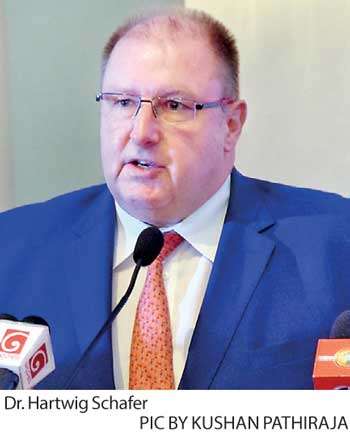15 Feb 2019 - {{hitsCtrl.values.hits}}
 By Shabiya Ahlam
By Shabiya Ahlam
The World Bank yesterday tipped Sri Lanka as one of the stronger economies in the South Asian region, but asserted the country is yet to reach its full potential, and will struggle to do so until it gets the much needed economic and fiscal reforms on track.
World Bank Vice President South Asia Region Dr. Hartwig Schafer, who is on a brief visit to Sri Lanka said, the development lender remains positive of the island nation being “well on the road” towards reaching upper-middle income status.
But he stressed there are a number of pressure points that require urgent attention.
“Why are we (Sri Lanka) not reaching the full potential? There is a need to break the fiscal pressures. There is a need to look at the expenditure, the high losses of the State-owned enterprises, and make sure there is some spending to the social sector,” Dr. Schafer said in his address at the launch of Sri Lanka Development Update in Colombo yesterday.
According to him, the country’s growth rate should ideally be around 6 percent as opposed to the current 3.4 percent as much “hard work” is observed to have been carried out in the areas of economic reforms to achieve higher growth rates, alongside being backed by a skilled labour force.
It was stressed that one of the major pressure points faced by Sri Lanka is the huge debt burden which in turn has dampened the performance of the country and the overall confidence of the economy.
The Sri Lanka Development Update pointed out that the country’s debt management has not evolved sufficiently for many decades to deal with emerging challenges.
Although the costs and risks of the debt portfolio have been evolving along with market access, market development, use of new instruments and increased vulnerabilities in the global environment, Sri Lanka’s debt management function and structures have not kept pace.
The report stated that deficiency in Sri Lanka’s debt management is a holistic view, which covers all related functions from planning to risk management, in the absence of a dedicated unified institutional framework.
Dr. Schafer pointed out that in the present context, the fragmented institutional framework and lack of a comprehensive debt management strategy lead to important risks being not addressed.
The World Bank noted that restrictive trade policies over the past decade have created a strong anti-export bias, which has been reflected in a dramatic decline in trade.
Dr. Schafer affirmed that the World Bank will continue to extend to the country the required support towards reforms and will assist in creating the necessary “vibe” to increase the flow of Foreign Direct Investment (FDI).
With the World Bank currently is facilitating about 14 projects to the tune of US $ 1.8 billion, across diverse sectors, Dr. Schafer said the agency will “do more of that” to bring in newer investments to help the island nation have access to financing at lower costs to help reduce the cost of borrowing.
No improvement in female participation in local workforce
Despite Sri Lanka being recognized for the conceptualization of policies to pull in more females to the workforce over the years, those efforts have borne limited results, the World Bank highlights.
Of the total labour force of 6.67 million in Sri Lanka, only 36 percent are women, and the level of participation has witnessed little or no change over the last two decades despite the government’s continued efforts.
Acknowledging that challenges continue to mount from different aspects when it comes to keeping females engaged in the economy, World Bank Senior Country Economist Fernando Im noted that Sri Lanka is moving towards a shrinking labour supply, which will slowdown the country’s economic growth.
“Therefore, it becomes essential to close the gender gap in labour force participation through policies that foster women’s entry and retention,” he said.
He further stressed that the polices should include improving the supply of child care and elder care services, safe transport, and flexible work arrangements for women, as currently such factors are cited to be keeping females away from work.
He added that closing the gender gap in terms of labour force participation would buffer the impact coming from the reduction in the number of workers.
Acknowledging the low female participation in the labour force, researcher Dr. Ramani Gunatilaka noted that the government has done “absolutely nothing” to help reduce the burden of women and help them remain at work. She pointed out that from the country’s poorly structured education system that has shifted much of the workload from school to the parents, to the absence of proper child care support, have resulted in women dropping out from the workforce.
Sharing similar sentiments, Colombo University economist Dr. Amala de Silva noted that adding to the issue is the stereotype of women, stemming from notions such as “having the perfect house and being the perfect mother”.
Fertility rates are linked by economist to the chances of females entering and remaining in the workforce.
In the case of Sri Lanka, between 1996 and 2016, the fertility rate fell from 2.3 to 2.0 births per women. However, these changes did not translate into higher number of women entering the labour market.
This contrasts sharply with the evolution of female labour force participation in other countries such as Colombia, Korea, Malaysia, and Uruguay where a significant drop in fertility rates did result in increased female participation.
15 Nov 2024 7 hours ago
15 Nov 2024 9 hours ago
15 Nov 2024 9 hours ago
15 Nov 2024 15 Nov 2024
15 Nov 2024 15 Nov 2024